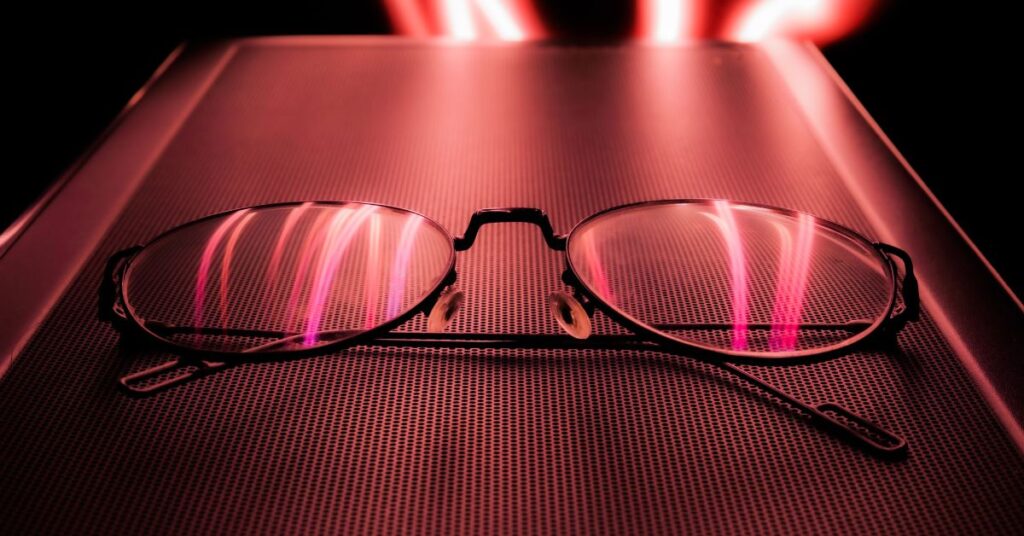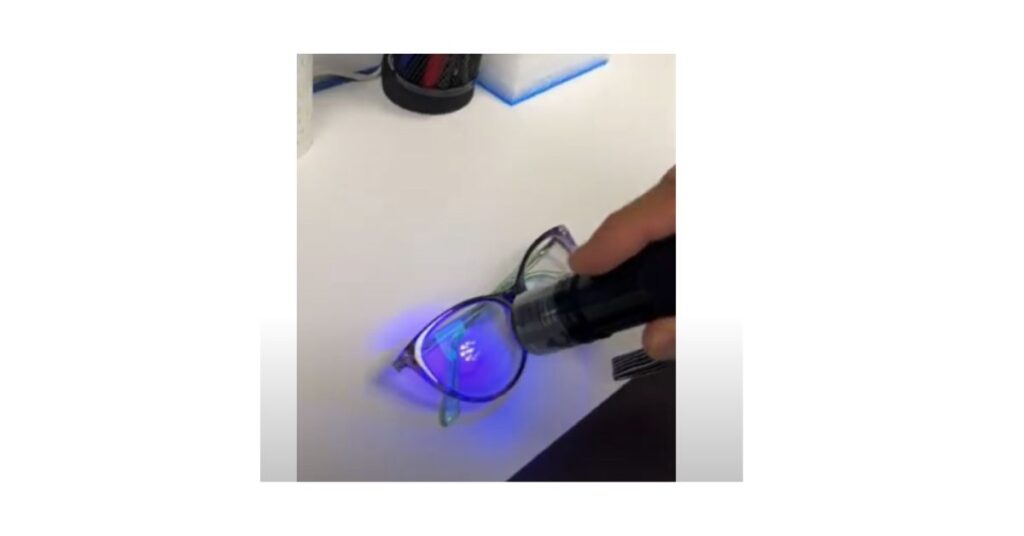In this tech-savvy world, our eyes often bear the brunt of constant screen time, and that’s where blue light glasses come into play. But, let’s be real – do they work? Are they the magical solution to our digital eye strain problems? We’re breaking down the nitty-gritty of how to tell if blue light glasses are doing their job. No tech jargon, just simple and practical insights to help you make the best call for those peepers of yours. Let’s Started!
Table of Contents
Why It’s Important to Tell If Blue Light Glasses Work?
Our daily lives are increasingly intertwined with screens, be it from smartphones, laptops, or tablets. And let’s face it, our eyes sometimes bear the brunt of this digital overload. Enter blue light glasses, marketed as the superheroes saving our eyes from the harmful effects of prolonged screen exposure.
But, hold up! It’s crucial to know if these glasses are more than just a stylish accessory. Understanding their effectiveness matters because, well, our eyes deserve the best protection. If blue light glasses can genuinely reduce eye strain, minimize headaches, and improve sleep quality, then they’re worth considering. On the flip side, if it’s all just a marketing gimmick, we might be better off saving our money.
In short, figuring out whether blue light glasses work helps us make informed decisions about our eye health in this digital age. So, let’s unravel the mystery and ensure those stylish frames on our noses are doing more than just looking good!
Using a Reflection Test to Tell If Glasses Are Blue Light

let’s get hands-on with a quick and easy reflection test to figure out if your blue light glasses are the real deal. Here’s what you need to do:
- Grab a White Light Source: Get yourself a white LED flashlight or any white light source. Make sure it’s not a warm or yellow light – we want that crisp white glow.
- Find a Reflective Surface: Head to a mirror or any other reflective surface. This could be your phone screen when it’s turned off or even a glossy magazine.
- Examine the Reflection: Put on your blue light glasses and shine the white light onto the reflective surface. Take a look at the reflection of the lenses. If they’re truly blocking blue light, you should see a faint yellow or orange tint in the reflected light.
- Compare Without Glasses: Now, take off the glasses and shine the light again. If the glasses are effective, you should notice a difference in the color of the reflected light – it’ll be less yellow or orange compared to when you were wearing the glasses.
It’s always a good idea to consider other factors like your overall comfort, reduction in eye strain, and any improvements in sleep quality.
Using a Spectrophotometer to Tell If Glasses Block Blue Light
If you’re up for a more scientific approach to checking the effectiveness of your blue light glasses, a spectrophotometer can provide precise measurements. Here’s a step-by-step guide:
- Gather Your Equipment: Obtain a spectrophotometer, which measures the intensity of light across different wavelengths. You may find one in a laboratory or use a smartphone app that transforms your phone’s camera into a spectrophotometer.
- Choose a Light Source: For accurate results, use a calibrated light source that emits blue light in the range of 400-500 nanometers, as this is where blue light typically falls.
- Baseline Measurement: Take a baseline measurement without wearing the blue light glasses. Record the intensity of blue light reaching the spectrophotometer.
- Wear the Blue Light Glasses: Put on your blue light glasses and repeat the measurement. The spectrophotometer will display the intensity of blue light that penetrates the lenses.
- Compare the Results: Analyze the data. If the spectrophotometer registers a significant reduction in the intensity of blue light while wearing the glasses, it indicates its effectiveness in blocking blue light.
If you’re not familiar with spectrophotometry, consulting an optometrist or eye care professional could be beneficial. So, gear up with your science hat and let the numbers reveal the true prowess of your blue light blockers!

Use an RGB test to tell if glasses are blue light
If you’re looking for a straightforward and accessible way to assess blue light blocking in your glasses, an RGB test using your computer screen can be quite handy. Follow these steps:
- Access an RGB Test Online: Several websites are offering RGB tests. Just search for “RGB test” on your preferred search engine, and you’ll find options that display red, green, and blue colors.
- Baseline Test Without Glasses: Begin by taking the test without wearing your blue light glasses. Observe the colors and note any strain or discomfort.
- Put On Your Blue Light Glasses: Now, put on your blue light glasses and take the RGB test again. Pay attention to whether the colors appear different or if there’s a reduction in eye strain compared to the baseline test.
- Compare the Results: If the glasses effectively block blue light, you might notice a subtle shift in the blue hues on the test. Additionally, if your eyes feel less fatigued or strained compared to the baseline, it suggests the glasses are doing their job.
This method provides a practical, visual assessment using the RGB spectrum commonly found on electronic screens. It’s user-friendly and doesn’t require any specialized equipment.
Using a Blue-Light Pen Test to Check Blue Light Glasses

If you’re looking for a simple and hands-on way to assess the effectiveness of your blue light glasses, a blue light pen test can provide quick insights. Here’s a step-by-step guide:
- Get a Blue-Light Pen: Obtain a blue-light pen, which emits blue light in the spectrum associated with digital screens (around 400-500 nanometers).
- Prepare a Dark Environment: Dim the lights in the room or do the test in a darker setting to enhance the visibility of the blue light.
- Baseline Test Without Glasses: Start by shining the blue-light pen on a white surface or a piece of paper without wearing your blue-light glasses. Observe the intensity and color of the blue light.
- Put On Your Blue Light Glasses: Now, put on your blue light glasses and repeat the test. Pay attention to whether the intensity or color of the blue light changes when viewed through the lenses.
- Compare the Results: Effective blue light glasses should noticeably reduce the intensity of the blue light or alter its color when viewed through the lenses. If you observe a significant difference, it suggests that the glasses are likely blocking or filtering blue light.
Keep in mind that this test is a simple and practical way to get a visual indication of blue light blocking. As always, consider overall comfort and personal experience along with the results of any test. Happy testing!
Conclusion
In the quest to decipher whether those trendy blue light glasses are pulling their weight, we’ve explored a range of tests – from the straightforward RGB check to the scientific spectrophotometer method. Each method has its own merits, offering insights into the potential effectiveness of blue light blocking.
Whether you opt for the reflection test, the RGB experiment, or the blue-light pen assessment, the key lies in paying attention to the nuances. Do you notice a shift in color hues? Is there a reduction in eye strain or discomfort? These are the real indicators that your blue light glasses might be doing the job.
However, it’s important to note that these tests provide a general sense and may not offer precise measurements. The effectiveness of blue light glasses can vary based on individual needs and the specific brand or type of glasses.
So, before you raise your glasses to a conclusion, consider the holistic picture. Listen to what your eyes are telling you, and if you’re still uncertain, consulting with an eye care professional can provide personalized insights.
In the end, the goal is clear: finding a balance between screen time and eye comfort. So, go ahead, put those glasses to the test, and may your eyes thank you for the extra care!
FAQ on How To Tell If Blue Light Glasses Work?
Do blue light glasses work?
Blue light glasses can be effective for reducing eye strain and improving sleep quality associated with prolonged screen time. However, individual experiences may vary, and scientific evidence is still evolving.
How can I tell if my blue light glasses are working?
You can try simple tests like the reflection test, RGB test, or using a blue-light pen to see if there’s a noticeable reduction in blue light or eye strain when wearing the glasses.
Can I wear blue light glasses all the time?
While you can wear blue light glasses throughout the day, it’s not necessary unless you spend extended hours in front of screens. It’s essential to strike a balance and give your eyes breaks.
Can blue light glasses improve sleep?
Blue light exposure, especially at night, can interfere with sleep patterns. Blue light glasses may help mitigate this effect by reducing exposure before bedtime, potentially improving sleep quality.
Are there any side effects of wearing blue light glasses?
In general, blue light glasses are considered safe. However, some individuals may experience mild discomfort initially. If you have concerns, consult with an eye care professional.
Can I use a smartphone app to test blue light blocking?
While some apps claim to test blue light blocking, they may not be as accurate as specialized tools. For a more reliable assessment, consider using dedicated equipment or consulting with a professional.



